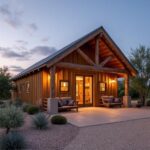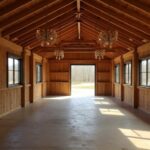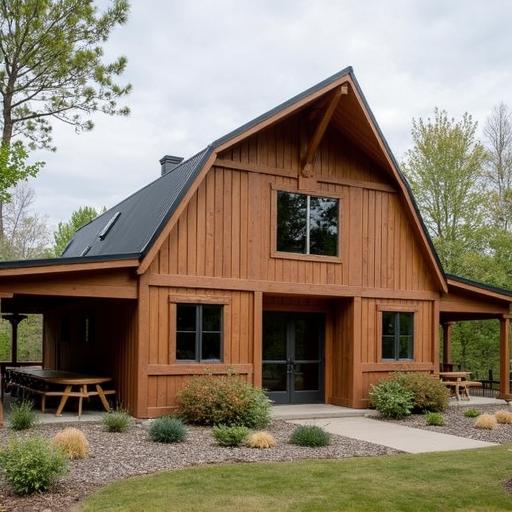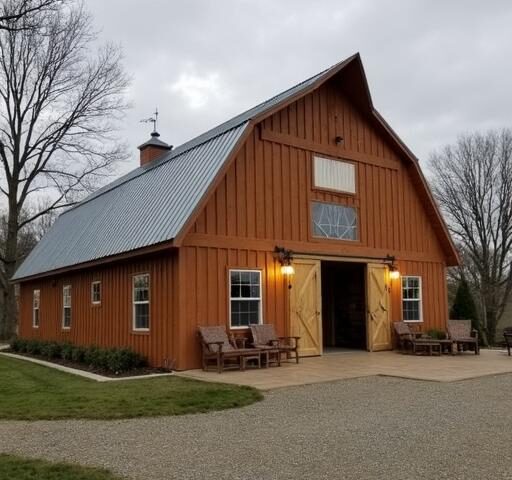
Barndominium for Sale Tucson AZ: Your Dream Home Awaits
July 21, 2025
Interior Barndominium: Discover Stunning Modern Charm
July 22, 2025Barndominiums have emerged as a popular residential alternative, blending the rustic charm of barns with modern living comforts. These unique structures not only serve as functional homes but also reflect a growing trend toward simplified, cost-effective living. As more people look to build their own barndominiums, one critical question arises: how long does it take to build a barndominium? Understanding construction timelines is essential for aspiring homeowners who want to manage expectations and plan accordingly.
Several factors can influence the length of time required to construct a barndominium. From the complexity of the design to the necessary permits and local weather conditions, each element can have a significant impact on the overall timeline. For instance, larger or more intricately designed structures may require additional resources and time compared to simpler models. Additionally, unforeseen delays due to permitting issues or adverse weather can prolong the construction process, making effective planning more important than ever.
Before construction officially begins, there are several preliminary steps that must be addressed during the planning phase. Site selection, architectural design, and obtaining permits all contribute to an incorporated timeline that needs careful consideration. Often overlooked, this pre-construction period is crucial for ensuring that everything runs smoothly once building starts. By taking these initial steps seriously and allowing sufficient time for completion, builders can facilitate a much-improved overall timeframe for constructing their dream barndominium.
Factors Influencing Construction Time
The construction of a barndominium is influenced by a multitude of factors that can significantly impact the overall timeline. One of the primary elements affecting how long it takes to build a barndominium is the design complexity. Custom designs with unique architectural features or specialized layouts will naturally require more time for both planning and execution compared to standard designs.
Builders have to account for intricate details, which can slow down both the drafting and the construction phases. Moreover, if structural adjustments or custom finishes are required midway through the project, these modifications can further prolong timelines.
Permitting also plays a crucial role in determining how long does it take to build a barndominium. Each municipality has its own set of regulations, and obtaining necessary permits before beginning construction can sometimes lead to unexpected delays.
Depending on where you live, this process could take weeks or even months, especially if there are any discrepancies during inspections or public hearings. It’s essential for prospective barndominium owners to allocate considerable time for this step so that they do not encounter setbacks during construction.
Weather conditions should not be overlooked either; they can drastically affect building schedules. Adverse weather, like heavy rains or winter storms, can halt work on-site and lead to significant delays in completion timelines.
Builders often have to plan around seasonal variations-choosing spring or early summer may optimize conditions for uninterrupted construction activities. Additionally, coordinating with contractors and ensuring all materials are available when needed tie back into overall duration as well; unforeseen shortages or delivery delays can instantly elongate the schedule.
| Factor | Impact on Timeline |
|---|---|
| Design Complexity | Increased planning and execution time due to custom features. |
| Permitting Process | Can take weeks or months; regulatory issues might cause delays. |
| Weather Conditions | Adverse weather may halt work; best seasons for building vary by location. |
Pre-Construction Phase
Understanding the Pre-Construction Process
Before the actual construction of a barndominium can commence, several key steps must be taken during the pre-construction phase. This critical stage involves thorough planning and design, laying the groundwork for a successful building experience.
First and foremost, site selection is paramount; choosing an ideal location that aligns with your lifestyle and budget will have an immediate effect on how long does it take to build a barndominium. Factors such as accessibility to utilities, zoning regulations, and land topography all play significant roles in determining how smoothly the entire project will proceed.
Once the site is selected, architectural design comes into play. Engaging with architects or designers experienced in barndominium layouts can help translate your vision into workable blueprints. This process often includes selecting floor plans, materials, and aesthetics that suit your preferences while also adhering to local building codes. Effective collaboration with these professionals can streamline decision-making processes and minimize potential delays during construction.
Securing necessary permits is another vital aspect of this phase. Permitting procedures vary significantly by region; some local governments may have stringent requirements that necessitate extensive documentation before granting approval to begin building.
Understanding these local regulations early in the process-and allowing time for revisions if needed-can dramatically influence how long it takes to build a barndominium. Since timelines for permit approvals can range widely from days to months based on jurisdictional factors, it’s crucial for prospective builders to factor these possibilities into their overall schedule.
Potential Delays in Pre-Construction
While planning and design are essential components of preparing for construction, several common pitfalls can lead to unexpected delays. For instance, making last-minute changes to designs or materials after initial approvals can result in lengthy revisions that stall progress significantly. Similarly, failure to account for seasonal constraints may push back timelines as certain permits might not be issued until after inspections occur during favorable weather conditions.
Additionally, communication lapses between homeowners and contractors regarding expectations and deliverables may create misunderstandings about deadlines and responsibilities within the pre-construction stage. To combat this issue effectively, maintaining open lines of communication throughout all stages-from conceptual discussions right through securing final permits-ensures that both parties remain aligned on goals and timelines moving forward.
Investing time in thorough pre-construction planning ultimately contributes positively towards the efficiency of subsequent phases of construction as well as minimizing the stress involved throughout this exciting journey of building a dream home like a barndominium.
Construction Timeline Estimates
Foundation Stage
The foundation stage is one of the most critical phases in building a barndominium. Typically, this process can take anywhere from two to four weeks, depending on various factors such as site preparation and weather conditions.
The type of foundation chosen-whether it be a slab, crawl space, or full basement-can also influence the timeline. For example, a slab foundation usually requires less time compared to constructing a crawl space or basement due to fewer materials and simpler designs involved.
Additionally, proper curing is vital for concrete slabs to ensure structural integrity. If inclement weather, such as heavy rains or extreme cold temperatures, occurs during this period, it can significantly delay the entire construction schedule. Homeowners should anticipate these potential setbacks and account for them in their overall planning.
Framing and Roofing
Once the foundation is laid and dried sufficiently, the next major step involves framing and roofing. This part of building a barndominium generally takes between three to six weeks. Framing includes erecting walls and roofs that form the skeleton of your home; this stage relies heavily on Labor availability as well as the complexity of design choices made earlier in the planning phase.
Customization during framing can alter timelines significantly. For instance, if you decide to add vaulted ceilings or large open spaces instead of traditional layouts with internal walls, extra labor may be required not only for better craftsmanship but also for meeting code requirements-all adding weeks to your construction timeline. Furthermore, installing roofing systems made from different materials (metal vs asphalt shingles) might affect duration based on their respective installation processes.
Interior Finishes
Once framing and roofing are completed, interior finishes begin-including electrical work, plumbing installation, drywall hanging, painting, flooring installation, kitchens and bathrooms setup-all these tasks contribute significantly to how long does it take to build a barndominium before it’s ready for habitation. This phase usually spans anywhere from four to eight weeks based on how comprehensive your design specifications are.

A more straightforward approach results in faster completion times while custom features like intricate cabinetry or upscale appliances could extend this timeline considerably. It’s essential during this phase to maintain clear communication with contractors regarding any changes in design or preferences since alterations may disrupt planned workflows and further delay overall progress towards moving into your new barndominium.
Labor and Material Availability
Building a barndominium requires a careful balance of planning, labor, and material availability to achieve the desired timeline. Understanding how long it takes to build a barndominium can be significantly impacted by these factors. Labor availability refers to the factors surrounding skilled workers, subcontractors, and construction managers who can effectively bring your project to life. Fluctuations in labor supply can extend or shorten construction times depending on local market conditions and the level of expertise required for specialized tasks.
Material availability plays an equally critical role. Construction projects often rely on various materials such as steel, lumber, roofing components, and finishes that need to be sourced in alignment with the project timeline. Delays in procurement can arise from several scenarios:
- Market Demand: A high demand for certain materials can lead to shortages.
- Supply Chain Disruptions: Issues such as transportation delays or supplier reliability impact product delivery times.
- Seasonal Trends: Certain materials may have seasonal pricing fluctuations or availability constraints.
Due to these complexities, it’s important for prospective builders to stay informed about market trends and establish relationships with suppliers early in their planning process.
To mitigate potential issues stemming from labor and material availability, it is advisable to take proactive steps prior to breaking ground. One effective strategy is conducting thorough research on local contractors and supply sources well in advance of your planned start date.
This could involve gathering recommendations from others who have built similar structures or consulting industry experts who are aware of current market dynamics. Furthermore, considering alternative materials or flexible timelines for customizations might also speed up the overall construction process.
In addition, engaging professionals familiar with barndominium construction can help pinpoint realistic timelines tailored to your unique circumstances. This insight will ultimately enhance your understanding of what influences how long it takes to build a barndominium while ensuring that you are well-prepared for any unexpected challenges along the way.
Seasonal Considerations
Seasonal factors play a significant role in determining how long it takes to build a barndominium. The impact of weather can delay construction timelines and affect the overall efficiency of the building process. Each season has its distinct characteristics that can either facilitate or hinder construction activities.
For instance, harsh winter conditions can lead to frozen ground, making it difficult for excavators to dig foundations or complete site preparations. This may extend the timeframe needed before any substantial building work can begin.
Conversely, summer heat presents its own challenges. High temperatures can create uncomfortable working conditions for laborers, potentially slowing down productivity. Additionally, if high humidity accompanies the heat, it can complicate certain building tasks such as pouring concrete or installing certain types of insulation. Understanding these seasonal variables is crucial when planning your construction timeline, as builders often need to factor in weather-related delays while providing estimates for how long does it take to build a barndominium.
Timing your project start date strategically can mitigate many of the potential delays caused by seasonal issues. Early spring or fall are generally considered ideal times to break ground on a barndominium build since they offer milder weather conditions that are conducive to various construction tasks.
However, it’s essential to keep an eye on local climate trends and patterns that could also influence specific timeframes in different regions. By acknowledging seasonal considerations ahead of time, you’ll be better prepared for the possible ramifications on your construction schedule.
| Season | Potential Impact on Construction |
|---|---|
| Winter | Frozen ground may delay foundation work; snow/ice increases risks and halts outdoor activities. |
| Spring | Mild weather encourages progression but rains may cause temporary slowdowns. |
| Summer | Heat may reduce worker output; high humidity complicates some building tasks. |
| Fall | Optimal weather for construction; cooler temperatures enhance productivity. |
Post-Construction Timeline
After the construction phase of a barndominium is completed, it’s not quite time to move in just yet. The post-construction timeline includes several crucial steps that are essential to ensure the structure meets safety and quality standards before residents occupy it. This phase typically entails inspections, finishing touches, and final walkthroughs to confirm that every aspect of the build has been completed satisfactorily.
First, inspections will often be conducted by local building officials or third-party inspectors. These inspections serve a valuable purpose: they check compliance with health and safety codes as well as with the original plans submitted for permits.
Depending on your location and the specific regulations involved, these inspections can take anywhere from one week to several weeks to schedule and complete. It’s advisable to factor this time into your overall timeline when considering how long does it take to build a barndominium.
Once inspections have been successfully passed, attention turns towards finalizing details within the space. This stage may include:
- Interior finishes: Such as flooring installation, cabinetry setup, and painting.
- Utilities setup: Ensuring all plumbing, electrical systems, heating, and cooling functions correctly.
- Landscaping: Completing outdoor work like grading soil or planting grass which might add time depending on weather conditions.
These finishing touches can vary widely in duration based on individual preferences for design upgrades or customizations within the barndominium. Normally, this post-construction period adds an additional few weeks to months onto your overall project timeline, emphasizing why thorough planning is so critical right from the onset of building your barndominium. With careful coordination between contractors and other professionals during this final stretch, you can aim for a smooth transition from build completion to moving in.
Conclusion
In summary, building a barndominium is an exciting venture that has gained significant traction as a popular residential option. However, prospective builders must confront the fundamental question: how long does it take to build a barndominium? The timeline for construction can vary widely based on several factors, ranging from the complexity of the design to local permitting procedures and material availability. Each of these elements plays a crucial role in shaping the overall duration of your project.
It is essential to understand the different phases involved in constructing a barndominium-from initial planning and design to final inspections. The pre-construction phase often takes considerable time due to site selection, architectural considerations, and securing necessary permits.
Once you transition into actual construction, various stages such as laying the foundation, framing, and roofing come into play, each with its own estimated timelines. Additionally, seasonal considerations should not be overlooked; embarking on your project at an optimal time of year can contribute significantly to an efficient building process.
Ultimately, patience and thorough research are key when answering how long it takes to build a barndominium. Engaging with experienced builders and architects can help provide personalized insights that cater to your specific circumstances.
By being proactive in planning and staying informed about potential influences such as labor shortages or material delays, you can mitigate unexpected setbacks while ensuring your dream home becomes a reality in a timely manner. As you move forward with this endeavor, remember that preparation will pave the way for success in creating your ideal space within a transformed barn.




